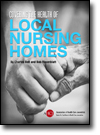CaliforniaWatch’s Christina Jewett and Agustin Armendariz put some serious time into an investigation of the results of a 2004 law that directed an extra $880 million to California nursing homes, yet didn’t come with a whole lot of safeguards as to how that money would be used. It was intended to help the homes ameliorate staffing shortages and boost wages, but, they write, at least “232 homes did just the opposite. They either cut staff, paid lower wages or let caregiver levels slip below a state-mandated minimum.”
Many nursing homes appeared to use the cash infusion to help bolster their bottom lines, according to a California Watch analysis of state nursing home data. Among the 131 homes that cut staff by 2008, the median profit was 35 percent more than other homes in the analysis.
At the same time, the analysis shows, about two dozen homes that made the deepest caregiver cuts had about one-third more deficiencies than other state facilities. State inspectors noted a litany of violations that included neglecting bedsores and giving patients the wrong drugs.
And, furthermore, there appears to be a loophole in the law that allows that extra money, which again was intended to improve care, to be spent fighting all these inspection violations.
When homes are cited with serious violations, the 2004 state law helps bail them out.
Homes are allowed to bill for administrative costs such as legal fees. That means facilities can charge the state to fight state-issued fines and citations for substandard care.
How they did it
Jewett’s story is accompanied by a detailed breakdown of how she arrived at her conclusions. It focuses on what she and CAR specialist Armandariz did with the data and only touches on how she acquired it. She also discusses how she shared her data and conclusions with an industry group before publication and modified them slightly based on the group’s input.
Supplementary materials from CaliforniaWatch
- Graphic: Track how nursing homes are paid for Medi-Cal patients
- Graphic: How one nursing home chain boosted profits while staffing rates fell
- Graphics and database: State boosts nursing home pay by $880 million
 Slim guide:
Slim guide:
Covering the Health of Local Nursing Homes
This reporting guide gives a head start to journalists who want to pursue stories about one of the most vulnerable populations – nursing home residents. It offers advice about Web sites, datasets, research and other resources. After reading this book, journalists can have more confidence in deciphering nursing home inspection reports, interviewing advocacy groups on all sides of an issue, locating key data, and more. The book includes story examples and ideas.
AHCJ publishes these reporting guides, with the support of the Robert Wood Johnson Foundation, to help journalists understand and accurately report on specific subjects.

• More investigations of nursing homes
• Aging Nation: Troublesome Health Care Issues
• Headlines an advocate for seniors would like to see
• The impact of aging upon health care
• Covering nursing homes and other issues of aging
• How will retiring boomers affect the national health agenda?
• You Can Run, but You Can’t Hide: Policy and Problems in Long-Term Care
• Biology of Aging: Sources and Resources
Related
The San Francisco Business Times‘ Chris Rauber writes that the Center for Investigative Reporting, the California news nonprofit that produces CaliforniaWatch.org, has continued its fundraising run with $440,000 from The California Endowment. The money will be used to launch a community health reporting beat and to hire a “public engagement liaison,” Rauber writes.
CIR has raised more than $6 million over the last 18 months, including a total of $850,000 in March for its California Watch and other initiatives, officials said April 14.
…
Over the last year, CIR’s staff has nearly tripled, from 8 to 22, and four more hires are planned over the next two months, officials said. It launched California Watch, billed as the largest investigative journalism unit in the state, last September.




